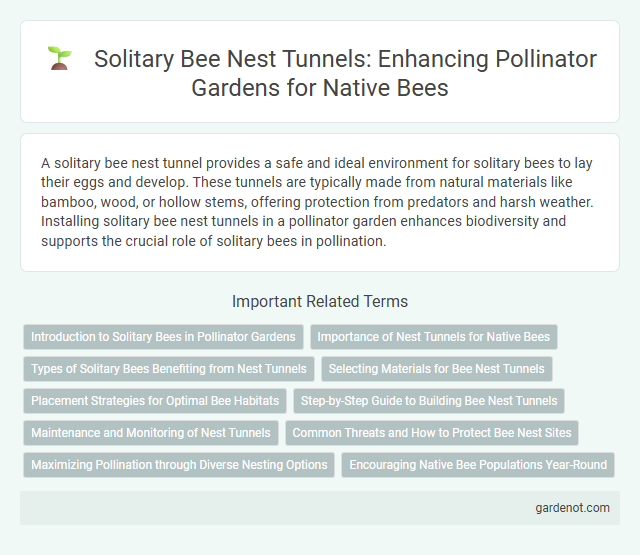A solitary bee nest tunnel provides a safe and ideal environment for solitary bees to lay their eggs and develop. These tunnels are typically made from natural materials like bamboo, wood, or hollow stems, offering protection from predators and harsh weather. Installing solitary bee nest tunnels in a pollinator garden enhances biodiversity and supports the crucial role of solitary bees in pollination.
Introduction to Solitary Bees in Pollinator Gardens
Solitary bees are essential pollinators that thrive in pollinator gardens by nesting in small tunnels within dead wood, hollow stems, or specially designed bee blocks. These solitary bee nest tunnels provide a safe habitat for individual female bees to lay their eggs, ensuring the growth of future pollinator populations. Incorporating solitary bee nest tunnels into pollinator gardens enhances biodiversity and supports the pollination of native plants and crops.
Importance of Nest Tunnels for Native Bees
Nest tunnels serve as crucial habitats for native solitary bees, providing safe spaces for egg-laying and larval development. These tunnels protect offspring from predators and harsh environmental conditions, enhancing bee survival rates. Ensuring the availability of diverse nesting tunnels in pollinator gardens supports native bee populations and promotes biodiversity.
Types of Solitary Bees Benefiting from Nest Tunnels
Solitary bee nest tunnels provide essential habitat for species such as leafcutter bees, mason bees, and mining bees, which use narrow tubular cavities for egg-laying. These nest tunnels mimic natural environments like hollow stems and wood borings, supporting the lifecycle of Osmia, Megachile, and Andrena genera. Creating diverse tunnel diameters ranging from 2 to 10 millimeters attracts a wider variety of solitary bees, enhancing pollination in garden ecosystems.
Selecting Materials for Bee Nest Tunnels
Selecting materials for solitary bee nest tunnels requires a focus on natural elements like untreated wood, bamboo, or paper tubes to mimic their preferred nesting habitats. These materials provide proper insulation and protection from weather while preventing mold growth and parasites. Ensuring tunnels have smooth inner surfaces and varied diameters between 3 to 10 millimeters optimizes suitability for different solitary bee species.
Placement Strategies for Optimal Bee Habitats
Position solitary bee nest tunnels in locations receiving morning sunlight to warm the tunnels and activate bee activity early in the day. Ensure the tunnels are sheltered from strong winds and heavy rain to protect developing larvae. Place the nests near diverse flowering plants within 300 meters to provide reliable foraging resources essential for solitary bee health and reproduction.
Step-by-Step Guide to Building Bee Nest Tunnels
Constructing solitary bee nest tunnels begins with selecting untreated wood blocks or bamboo tubes, approximately 6-8 inches long and about 3/8 inch in diameter, mimicking natural nesting habitats. Drill smooth, dead-end holes spaced at least half an inch apart to prevent damaging the bees during their entry and exit. Position the tunnels in a sunny, sheltered area facing south or southeast, ideally 3 to 5 feet above ground, to provide warmth and protection, encouraging solitary bees to establish nests.
Maintenance and Monitoring of Nest Tunnels
Maintenance of solitary bee nest tunnels requires regular cleaning and debris removal to prevent mold and parasite buildup, ensuring a healthy environment for bee larvae development. Monitoring involves inspecting tunnels for signs of successful nesting, such as sealed entrance holes and presence of pollen or nectar stores. Using non-invasive methods like visual observation or gentle probing helps track occupancy rates and early detection of potential infestations or blockages.
Common Threats and How to Protect Bee Nest Sites
Common threats to solitary bee nest tunnels include habitat destruction, pesticide exposure, and competition from invasive species, which disrupt nest integrity and bee reproduction. Protecting bee nest sites involves preserving natural nesting habitats, avoiding pesticide use around nesting areas, and installing artificial nesting blocks with proper drainage to prevent mold and predator access. Regular monitoring and community education on pollinator conservation further support solitary bee populations by maintaining healthy nest environments.
Maximizing Pollination through Diverse Nesting Options
Solitary bee nest tunnels provide critical habitats that enhance pollination by supporting diverse bee species with specific nesting preferences. Incorporating a variety of tunnel diameters and materials in pollinator gardens attracts multiple solitary bee species, each contributing uniquely to ecosystem pollination. This diversity in nesting options increases overall pollination efficiency, benefiting garden productivity and biodiversity.
Encouraging Native Bee Populations Year-Round
Solitary bee nest tunnels provide essential habitats that support native bee populations by offering safe, year-round nesting sites critical for their life cycles. These tunnels, often constructed from natural materials like bamboo or hollow reeds, help maintain biodiversity by fostering native pollinators essential for ecosystem health. Promoting solitary bee habitats contributes to sustained pollination services and resilience in local plant communities throughout all seasons.
Solitary bee nest tunnel Infographic

 gardenot.com
gardenot.com